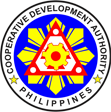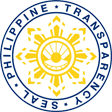COOPERATIVE DEVELOPMENT AUTHORITY
2018 Programs, Projects and Activities |
| Organizational Outcome: Growth and viability of cooperative enterprises improved |
| Programs |
Projects |
Activities |
| A. COOPERATIVE DEVELOPMENT PROGRAM (CDP) |
|
A.1. Handholding Program for Micro and Small cooperatives |
|
|
A.1.1. Capability Building Program for Cooperatives |
- Pre-Registration Seminar (PRS) for prospective cooperatives
- Conduct of Mandatory training for officers
- Conduct of Training on Compliance to Reportorial Requirements
- Conduct of enhancement training for cooperative officers
- Promotion of Koop Kapatid Program
|
|
A.1.2. Coop -Sustainable Enterprise Development-COOP-SEED (CDA-DTI Partnership Program) |
- Provision of enabling environment for access to technical and developmental government assistance
- Promote productivity and competitiveness of micro, small and entrepreneur-members.
- Promote adoption of value chain approach in cooperatives.
- Promote cooperative participation in the Negosyo Center projects
- Development of database on the contribution of cooperatives in job and income generation
- Develop Marketing Platform Arrangement
|
|
A.2. Strengthening partnership with National Government Agencies (NGAs), Local Government Units (LGUs), academe and other stakeholders
1. National Government Agencies (NGAs)
2. CDA – Local Government Units (LGU) |
- CDA-Department of Agriculture (DA) – Cooperatives’ Access to Credit
- CDA – Department of Agrarian Reform (DAR) – Capacity building of ARCs, provided with audit subsidy, etc.
- CDA-Department of Trade and Industry (DTI) – Participate in trainings offered in the Negosyo Center
- CDA – Insurance Commission (IC) – Securities and Exchange Commission (SEC) – Bangko Sentral ng Pilipinas (BSP)
- National Commission on Muslim Filipinos (NCMF)
- Department of Social Welfare and Development (DSWD)
- National Commission on Indigenous Peoples (NCIP)
- National Commission on Culture and the Arts (NCCA)
|
|
A.3. Strengthening of Cooperatives as Business Enterprises |
- Conduct of Orientation on Financial Inclusion
- Institutionalized Savings and Mobilization & Capital Build Up Program (SMCBUP)
- Creation of Enabling Mechanism and Support Services for the Value Chain Program linkages with NGAs
|
|
A.4. Advocacy Programs and Initiatives |
- Cooperatives as Backbone to Federalism Program
- Implementation of Gawad Parangal for Cooperatives, Partners and Cooperative Leaders
- Documentation of cooperative stories
|
|
A.5. Information and Communication Program |
- Regional Advocacy and Communication Plan (RACP)
- Development and Distribution of Information, Education and Communication materials
- Conduct of Campaign Activities through Quad Media
- Cooperative Taxation Education
|
|
A.6. Accreditation Program for Training Providers, External Auditors, and Conciliators / Mediators |
|
|
A.7. Gender and Development Program (GAD) |
- Conduct of orientation on MCs on GAD Mainstreaming and GAD tools
|
|
A.8. Monitoring of Cooperative Development Councils (CDCs) |
|
|
A.9.Asset Recovery Program (Cleansing of Records/Writing off) |
- For legal action
- Cleansing of records
- Writing off of accounts
- Collection of loans/interest on investments
|
|
A.10. Humanitarian Leadership Academy (HLA) Program |
- Training on Business Continuity Management (BCM)
|
|
A.11. Anti-Drug Campaign Program |
- Conduct of orientation among coops for them to support the anti-drug campaign
|
|
A.12. Environment Protection Program |
- Environmental protection and/or preservation activities
|
| B. COOPERATIVE REGULATORY PROGRAM (CRP) |
|
B.1. Members and Public Protection Program |
- Registration of cooperatives and amendments to ACBL
- Recognition of Coop Branches, Satellites and Laboratory cooperatives
- CooPRIS Updating and enhancement
|
|
B. 1.1. Registration of Cooperatives and Expansion of Membership |
|
|
B.1.2. Monitoring of Cooperatives |
- Cooperatives inspection
|
|
B.1.3. Enforcement |
- Action on reported violations or complaints
|
| C. SUPPORT TO OPERATIONS (STO) |
|
C.1.Institutional Strengthening of CDA – Improved Developmental Service Delivery Mechanisms
C.1.1. Planning Formulation and Monitoring
C.1.2. Quality Management System Program |
Crafting of FY 2019 Work and Financial Plan
- Monitoring of Key Performance Indicators (KPIs)
- Conduct of Quarterly 5S Audits
- Conduct of Internal Audit
- Attendance to QMS-related trainings or activities
- Conduct of Surveillance Audits
|
|
C.2. MIS (Technical) |
- Implementation of ISSP, maintenance of CDA website
|
|
C.3. MIS (Analytics) |
- Consolidation and analysis of Work and Financial Plan Information System (WFPIS)
|
| D. GENERAL ADMINISTRATION SERVICES (GASD) |
|
D.1. General Services |
- Implementation of Motor Vehicle Maintenance Program
- Implementation of Building and Equipment Maintenance Program
- Disaster Preparedness Activities
|
|
D.2. Budget Preparation and Extension Program |
- Preparation of Annual Budget Proposal
- Preparation of Budget Execution Document (BEDs)
- Preparation of Financial Accountability Report (FARs)
- Preparation of monthly, quarterly, year-end financial report
|
|
D.3. Human Resource Development Program |
- Conduct of Training Needs Analysis (TNA)
- Conduct of Effectiveness Monitoring for Capacity Interventions
- Recruitment and Placement
- Crafting of Learning and Development Plan (LDP)
- Implementation of Strategic Performance Management System (SPMS)
- Monitoring of Effectiveness of Capacity Intervention
- Conduct of other Human Resource Development Activities
|
|
D.4. Property Management Program |
- Preparation of the Annual Procurement Plan (APP)
- Preparation of Procurement Monitoring Report (PMR) in the form prescribed by the Gov’t Procurement Policy Board (GPPB)
- Conduct of Physical Count of Inventories
- Conduct of disposal of unserviceable equipment and waste materials
|
|
D.5. Revenue Generation – Collection of Fees |
- Fees due to the CDA collected and duly receipted
|
|
D.6.Records And Document Management |
- Maintenance of the Records Room
- Disposal of Valueless Records in accordance with established guidelines of the National Archive of the Philippines (NAP)
|






